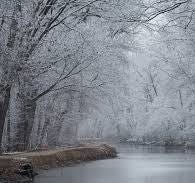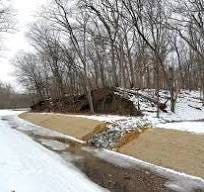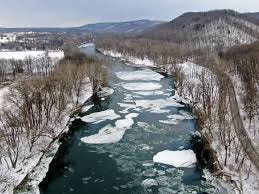How Does Ice Concentration Impact Your River System?
Sub Freezing Days Brought About By Multiple Cold Fronts Have Generated Ice Builds on Most River Systems
Most anglers are probably unaware that there is even such a thing as “ice restrictions” when it comes to access to waterways during the winter time especially in the Mid-Atlantic or Southeastern United States.
The recent weather that has dropped historic levels of snow and ice in the parts of the country the last few weeks has also brought with it historic low overnight temperatures. These temps have been brutal with regard to our river ecosystems.
Did you know there is a U.S. National Ice Center?
If we work our way east from the shore into our inland river systems we can see how the percentages of ice concentration drastically increases in the smaller creeks and river systems.
For five days in a row the temperature here never rose above freezing even in the middle of the afternoon thus allowing ice to build up from the banks into the river seams adjacent to shoreline. A times the ice can be as much as an inch thick in inland rivers and creeks and even thicker in the Highland areas where it is even colder overnight. Without the moving water or rising water anyway due to the fact none of the snow and ice has been really melting at a significant rate yet the water remains brutally cold and the ice remains intact.
Even though we may have tapped into the mid forties yesterday we have not really seen much of a change in the river as of yet.
NOAA data is one of best resources for anglers to evaluate the river system water temps throughout the region and can be accessed here:
https://www.weather.gov/marfc/watertemperatures
This will give you an updated water temp figure for most major river systems in the region (Middle Atlantic Region). The Upper Potomac continues to lag the James River in temps as James River has pushed back above 40 degrees while the Upper Potomac remains jammed between 36-38 degrees in many areas. This likely setms from the Greater Washington DC area and Western MD getting more snow fall than Central Virginia over the last few weeks.
Impact of Ice Concentration on River Systems
Water Temperature Stabilization
Ice acts as an insulator, reducing heat exchange between the water and the atmosphere. This leads to more stable, colder temperatures in the water beneath the ice, creating a winter thermocline.Reduced Gas Exchange
Ice limits oxygen exchange with the atmosphere. If snow accumulates atop the ice, light penetration decreases, reducing photosynthesis by aquatic vegetation and causing oxygen levels to drop further. This can lead to hypoxic (low oxygen) conditions, especially in slower-moving river sections or backwaters.Flow Dynamics and Ice Damming
Ice formations can alter river flow by creating blockages (ice dams), leading to reduced flow in some areas and pooling in others. These changes can disrupt habitat availability for fish and forage species.Water Clarity
Ice prevents turbulence from wind and reduces sediment suspension. This leads to increased water clarity under the ice but may also reduce nutrient mixing, impacting productivity for forage species.
Behavior of Our River Smallmouth
During prolonged ice concentrations, Smallies exhibit specific behavioral adaptations due to the cold, low-light, and oxygen-depleted environment:
Metabolic Slowdown
Cold water temperatures drastically slow their metabolism, reducing activity levels. Smallies will move very little, conserving energy by holding in deeper pools or areas with minimal current where temperatures are slightly more stable.Habitat Selection
Smallies will gravitate toward areas with higher oxygen levels, such as spring-fed zones, seams of moderate current, or locations with reduced sediment buildup. They avoid areas with significant ice dams or stagnation, where oxygen may be critically low.Reduced Feeding
Their feeding activity slows significantly, with occasional opportunistic feeding on slow-moving forage like crayfish, dying baitfish, or insect larvae. High-energy prey is avoided due to their limited energy reserves stored from feeding late Fall.Spring Staging
When ice persists longer than usual, Smallies DELAY their movement toward spring staging areas. Once the ice melts, the transition to spawning behavior may be compressed, with fish rapidly moving potentially from overwintering zones and deeper holes to shallow areas for pre-spawn feeding and ultimately spawn.
Behavior of Our Forage Species
Low Activity Levels
Forage species like minnows, shad, and insect larvae also reduce their activity under ice. They may form dense schools in oxygenated areas, making them more vulnerable to predation during brief feeding bursts by Smallies.Mortality Events
Prolonged ice cover and hypoxic conditions can result in "winterkill" events, particularly in slower backwaters or areas with high organic decay. Dead or dying forage species become a key food source for Smallies emerging from winter lethargy.Delayed Reproduction
Like Smallies, forage species delay reproduction when ice concentration persists into early spring, disrupting the timing of food chain dynamics and potentially reducing forage availability post-ice melt.
Impact on Aquatic Vegetation
Light Limitation
Ice and snow reduce sunlight penetration, halting photosynthesis for aquatic plants. This can lead to die-offs in submerged vegetation, further depleting oxygen levels.Regrowth Delay
Prolonged ice delays the regrowth of vegetation in spring. This affects habitat complexity for forage species and the prey availability for Smallies as vegetation provides critical shelter and food sources.Organic Decay
Dead plant material from ice-killed vegetation can accumulate in the sediment, increasing organic decay and contributing to hypoxia in some areas.
Water Clarity and Quality in Our River Systems
Increased Clarity Under Ice
Ice reduces turbulence and sediment suspension, leading to clearer water during winter months. However, this clarity can be offset by algal blooms that may occur immediately after ice-out as light penetration resumes.Oxygen Depletion
Ice cover restricts oxygen exchange, and decaying organic matter beneath the ice can exacerbate oxygen loss, particularly in areas with limited flow.Post-Ice-Out Dynamics
When the ice melts, increased flow from runoff can resuspend sediments, reducing clarity and delivering nutrients to downstream ecosystems. This surge in nutrients can spark productivity, but it may temporarily degrade water quality if pollutants are carried into the river system.
Behavioral Changes in Smallmouth Due to Prolonged Ice Cover
Delayed Movement: Smallies will delay their spring migrations to spawning areas.
Shift in Feeding Behavior: Feeding is opportunistic and focuses on winterkill or slower-moving prey.
Thermal Seeking: Smallies will actively seek zones with slightly higher temperatures post-ice melt.
Key Takeaways
Prolonged ice concentration has cascading effects on river ecosystems, impacting water quality, vegetation, forage species, and Smallies.
Smallies will respond by conserving energy, delaying movements, and adapting to limited prey availability.
Water clarity improves under ice, but nutrient-rich runoff after melting can alter clarity and stimulate productivity
Resources:
You Tube:
Smallie Chaser River Bassin:
You Tube: https://www.youtube.com/@TheSmallieChaserChannel
J.L. Scott Fishing
You Tube: https://www.youtube.com/@J.L.ScottFishing
TourneyX: Clubs (Virginia)
https://tourneyx.com/app/category/va---smallie-chaser-river-bassin
Community DISCORD: (Smallmouth Series)
https://discord.gg/KtpkAJchUP






